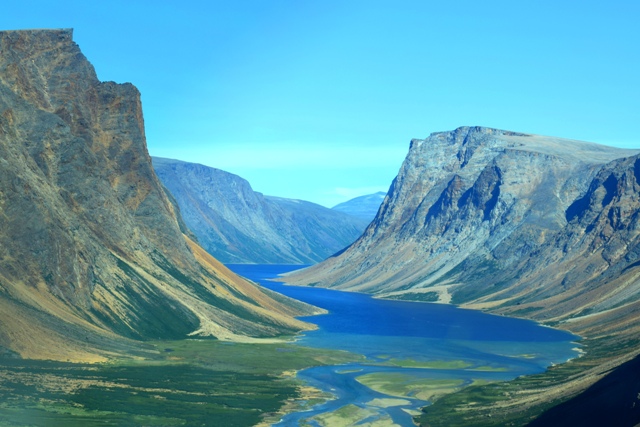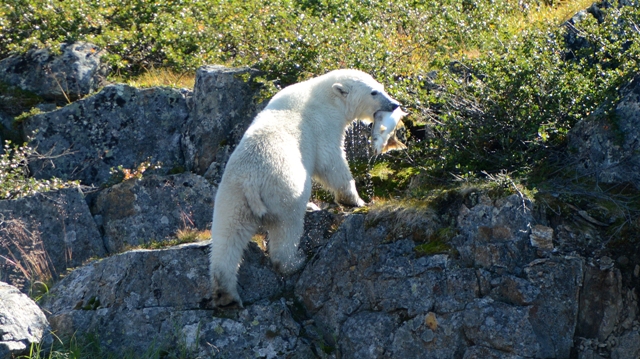

Nunavik
Ungava Bay is a huge, unrecognised and sparsely populated region. The harsh climate has forged landscapes here. The fauna and flora fight every day to survive and offer unforgettable moments to those who take time.
You have to be experienced to venture into it and the services of a guide are unavoidable. Your survival depends on it. Once you understand all this, be prepared for a radical change in your pace of life. There, we do not live according to a fixed schedule but rather with the conditions of the day. Let me explain…
Tides are among the highest in the world, up to 40 feet. This makes the logistics of operating boats and navigation complicated and has no alternative but to comply with it. We don’t go to sea when we want to, but when it’s time to do it. Depending on the tide tables, the schedules can be adjusted and you should be prepared to spend sometimes 8 to 10 hours without returning to the lodge.
Although it is necessary to be willing to accept such schedules, it is nevertheless a dream. The very first time I was dropped on an island surrounded by many bird, I realized all of a sudden that I “had to” spend 12 hours there, no less and no more.
In 12 hours, we have time to take the time. We study, observe and develop a strategy to capture this or that shot… and we have time to do it! The fact that you have to spend 12 hours in the same place is predictable (it may be the only predictable thing there) and so you prepare yourself accordingly.
The landscapes
They are unique… the particularity of this territory is that we can see far away… On the land side, the ancient glaciers have sculpted a relief that is not very accentuated by creating gaps in the rock. In the middle of the rocky hills, and green valleys, there are some very old spruce trees at ground level, twisted and full of stories. Rivers and streams find their way across a path to the salt waters of Ungava Bay.
Time takes on another dimension here. The sun barely escapes the horizon in the evening to rise a few minutes later, offering a striking spectacle of a play of colours and shadows. The days are long and you will have all the time you need to enjoy them.
Seaside
When Ungava Bay is like a mirror, it is time to get closer to the ice pack and icebergs. It’s very impressive… The experience of having an offshore lunch anchored on the ice is unique and the surrounding wildlife will make the show. The fantastic setting and atmosphere will drain your batteries and overload your memory cards.
Meeting Inuit who are passing through or who have come to hunt or fish will improve the day with new faces, a particular language and personalities that are adapted to the life of this region.
Wildlife
Everything is white in winter and everything is… very well camouflaged in summer. Even the polar bear that is year-round white is rather a dirty grey in the summer and difficult to locate if it does not move. Arctic foxes and hares take the same colour as rocks. Willow ptarmigan have the colours and texture of the tundra. But animals are everywhere and very active. Early July is the calving season and the adults are busy feeding their newborns. By following them from a distance, we can quite often spot their burrows. The animals I met there were completely disinterested in me and went about their daily routine as long as I respected an adapted attitude. This is the perfect situation to take behaviour photos, without any interaction between the subjects and the photographer.
Birds invade the islands for the most part. The rough-legged hawk dominates the tundra. Arctic terns, common eiders and mirror guillemots abound on the rocky islands where they nest. A very impressive bird, the catfish diving, is very present. He shares his territory with his older brother the common loon, which is less frequent.
In July, most geese and large snow geese have already left. By respective height, there are still rare sandhill cranes and trumpeter or piping swans. From the end of July to September, snowy owls are observed very frequently and are quite easy to lay.
Ungava Bay offers unique fauna, flora and landscapes… A guaranteed experience of life and exoticism. The perspectives are extraordinary for photographers looking for authenticity, landscapes and wildlife.
The guides are equipped with a VHF radio linked to the base at the main camp, survival equipment, distress rockets and a weapon adapted for the protection against polar bears. Boats are well adapted to navigation in northern waters. They are equipped with sonar and GPS for fog. The general rule is to always stay together (because of polar bears) and never go out alone at sea or on the tundra.
